Description
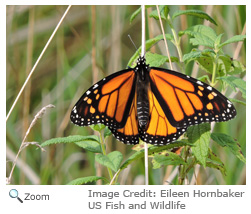 The monarch butterfly is reddish-orange with black vein-like markings. There is a black border around its wings with white spots on it. Its wings look like stained glass windows! When its wings are open, they are about four inches wide. The monarch butterfly is reddish-orange with black vein-like markings. There is a black border around its wings with white spots on it. Its wings look like stained glass windows! When its wings are open, they are about four inches wide.
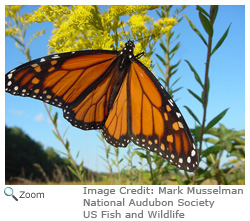 Males and females are similar in appearance, but the the black veins are thicker on the female's wings, and the male has small pouches on its hind wings where it stores
pheromones.
The bright orange of the monarch is
a type of advertising coloration that warns predators away. Males and females are similar in appearance, but the the black veins are thicker on the female's wings, and the male has small pouches on its hind wings where it stores
pheromones.
The bright orange of the monarch is
a type of advertising coloration that warns predators away.
Range
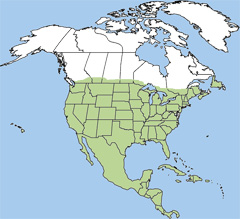 The monarch butterfly is found in North America from southern Canada
south to South America and the Caribbean. It is most common east of the Rocy Mountains and is not found in some areas of the Pacific Northwest and Alaska. Monarchs that live east of the Rocky Mountains usually overwinter in Mexico. Monarch that live east of the Roky Mountains may overwinter or live year-round in southern California. The monarch butterfly has also been established in Hawaii and Australia. The monarch butterfly is found in North America from southern Canada
south to South America and the Caribbean. It is most common east of the Rocy Mountains and is not found in some areas of the Pacific Northwest and Alaska. Monarchs that live east of the Rocky Mountains usually overwinter in Mexico. Monarch that live east of the Roky Mountains may overwinter or live year-round in southern California. The monarch butterfly has also been established in Hawaii and Australia.
Habitat
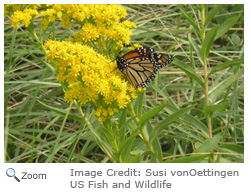 In the spring and summer, the monarch butterfly's habitat is open fields and meadows with milkweed. In winter, it is found on the coast of southern California and at high altitudes in central Mexico. In the spring and summer, the monarch butterfly's habitat is open fields and meadows with milkweed. In winter, it is found on the coast of southern California and at high altitudes in central Mexico.
Diet  Monarch butterfly larva feed on milkweed. Adults gather nectar from flowers. The monarch is not a very pleasant meal for predators. Monarch butterfly larva feed on milkweed. Adults gather nectar from flowers. The monarch is not a very pleasant meal for predators.
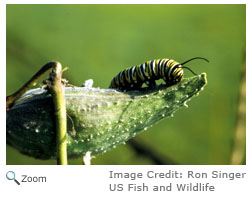 Eating milkweed causes the monarch to store alkaloid. This makes it taste horrible to predators! This is such an effective protection from predators, the the viceroy butterfly has adapted to look like the monarch so predators will leave it alone too! Eating milkweed causes the monarch to store alkaloid. This makes it taste horrible to predators! This is such an effective protection from predators, the the viceroy butterfly has adapted to look like the monarch so predators will leave it alone too! |
|
Lifecycle
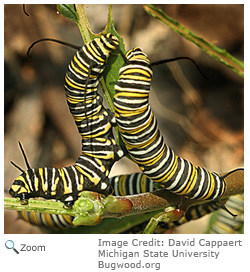 Monarch butterfly reproduction is a complicated process! It is tied in to the migratory patterns of the monarch. In the monarch's summer territory, which includes most of North America, monarchs will mate up to seven times. Each butterfly lives from two to six weeks. The male courts the female in the air, tackles her and breeds with her on the ground. As the monarchs migrate to their summer territory, the female lays her eggs on milkweed plants. The eggs take 3-15 days to hatch into larvae. The larvae feed on the milkweed for about two weeks. At the end of the two weeks, they attach themselves to a twig, shed their outer skin and change into a chrysalis. This happens in just a few hours! In two weeks, a full-grown monarch emerges! Monarch butterfly reproduction is a complicated process! It is tied in to the migratory patterns of the monarch. In the monarch's summer territory, which includes most of North America, monarchs will mate up to seven times. Each butterfly lives from two to six weeks. The male courts the female in the air, tackles her and breeds with her on the ground. As the monarchs migrate to their summer territory, the female lays her eggs on milkweed plants. The eggs take 3-15 days to hatch into larvae. The larvae feed on the milkweed for about two weeks. At the end of the two weeks, they attach themselves to a twig, shed their outer skin and change into a chrysalis. This happens in just a few hours! In two weeks, a full-grown monarch emerges!
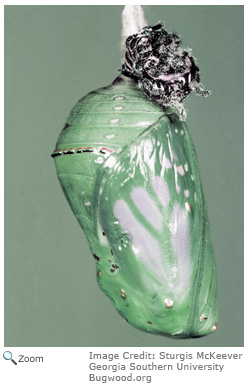 As fall approaches, non-reproductive monarchs are born. These are the butterflies that will migrate south. They will not reproduce until the following spring. These late summer monarchs travel hundreds and even thousands of miles to their winter grounds in Mexico and California. These monarchs need a lot of energy to make their trip! They store fat in their abdomens that helps them make the long trip south and survive the winter. During their five months in Mexico from November to May, monarchs remain mostly inactive. They remain perfectly still hour-after-hour and day-after-day. They live off of the stored fat they gained during their fall migration. As fall approaches, non-reproductive monarchs are born. These are the butterflies that will migrate south. They will not reproduce until the following spring. These late summer monarchs travel hundreds and even thousands of miles to their winter grounds in Mexico and California. These monarchs need a lot of energy to make their trip! They store fat in their abdomens that helps them make the long trip south and survive the winter. During their five months in Mexico from November to May, monarchs remain mostly inactive. They remain perfectly still hour-after-hour and day-after-day. They live off of the stored fat they gained during their fall migration.
 When they first arrive at their winter locations in November, monarchs gather into clusters in the trees. By December and January, when the weather is at its coldest, the monarchs are tightly packed into dense clusters of hundreds or even thousands of butterflies. By mid-February these clusters of butterflies begin to break up and the monarchs begin to gather nectar. In the spring, they reproduce and their offspring make the return trip to the north. When they first arrive at their winter locations in November, monarchs gather into clusters in the trees. By December and January, when the weather is at its coldest, the monarchs are tightly packed into dense clusters of hundreds or even thousands of butterflies. By mid-February these clusters of butterflies begin to break up and the monarchs begin to gather nectar. In the spring, they reproduce and their offspring make the return trip to the north.
Behavior
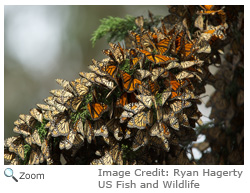 The monarch butterfly is a long-distance migrator. It migrates both north and south like birds do. But, unlike birds, individual butterflies don't complete migration both ways. It is their great-grandchildren that end up back at the starting point. The monarch butterfly is a long-distance migrator. It migrates both north and south like birds do. But, unlike birds, individual butterflies don't complete migration both ways. It is their great-grandchildren that end up back at the starting point.
In the fall, monarchs in the north gather and begin to move south. In North America, there are two large population groups that follow separate migration paths. Most monarchs east of the Rocky Mountains overwinter in the Sierra Madres in central Mexico where they live in fir forests at high altitudes. Far western populations of monarchs winter along the coast of southern California where they live in groves of pine, cypress, and eucalyptus trees. In the spring they head north and breed along the way.
Monarch migration back to the north is like a relay race! The original butterfly dies along the way, but the offspring it leaves behind continues on to the north where the cycle starts again in the fall. There are populations of monarchs in California, Florida, and Texas that don't migrate.
Video Credit: US Fish and Wildlife
|